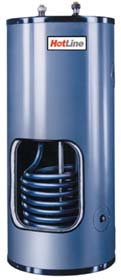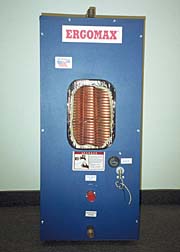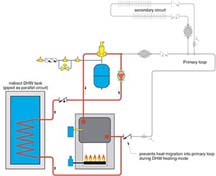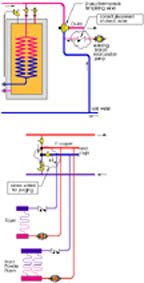
Cold water got one pass through a coiled copper heat exchanger mounted in the top of a boiler in which to transform itself into domestic hot water. With a demand of perhaps 1 to 4 gpm this could usually be accomplished, provided the boiler water temperature was always maintained in the range of about 140 to 200+ degrees F.
It comes as no surprise to most of you that tankless coils have limitations when it comes to modern hydronic heating. They require their "host boiler" to maintain relatively high water temperatures 24/365. This increases standby heat loss and lowers seasonal efficiency. In areas with hard water, tankless coils often limed up and required acid flushing on a regular basis. Tankless coils also create substantial pressure drops when operating at high flow rates. Their outlet temperature could also change significantly due to flow variations and burner cycling. Some systems use orifice devices to limit the flow through the tankless coil to help ensure adequate domestic hot water outlet temperature. Such devices can severely limit the flow available to modern plumbing fixtures.

Progress Has Been Made
Indirect water heaters came to life in the late '70s as many heating professionals began recognizing the limitations of tankless water heating in the overall context of modern hydronics technology.An indirect water heater is an insulated storage tank that does not produce its own heat, as does a typical "direct-fired" water heater. Instead, it uses an internal heat exchanger to transfer heat from a flowing stream of hot boiler water into domestic water. In most (but not all) indirect water heaters, hot boiler water flows through the heat exchanger, while the potable water resides within the tank. Since they're in contact with potable water, the tank and heat exchanger are usually constructed of stainless steel or lined with a heat-fused glazing.
One example of such a tank is shown in Figure 1. The coiled internal heat exchanger is located near the bottom of the tank where it will be immersed in the coolest water. This increases the rate of heat transfer from the coil to the potable water. The tank shell and heat exchanger are glazed. A 2-inch or thicker layer of insulation between the tank and external shell keeps heat loss to a minimum.

Still another approach to indirect water heating is shown in Figure 3. This design circulates boiler water through the insulated steel shell, while potable water passes though suspended copper heat exchanger coils. The temperature of the water in the tank is maintained at a suitable temperature at all times to provide the thermal storage necessary to meet high demands. The large surface area of the internal coils ensures efficient heat transfer.
Not all indirect tanks are vertically oriented cylinders. At least two North American suppliers currently offer horizontally oriented tanks designed to minimize the "footprint" of a typical boiler/DHW tank installation. They are mounted under the boiler as shown in Figure 4.

The Benefits
Indirect water heaters offer several benefits not provided by other means of water heating, including:In contrast, a properly selected indirect tank set up as a priority load can sink (e.g., transfer) the full Btu/hr. output of the system's boiler(s) into the tank water.
The Ratings
If you pull a few catalogs off the shelf to examine the performance rating provided by manufacturers of indirect water heaters, you're sure to find a variety of data. Most manufacturers provide a "first hour rating" which gives the gallons per hour the tank can deliver to a load at a specific outlet temperature. Two DHW outlet temperatures are commonly associated with these ratings: 110 degrees F and 140 degrees F. The ratings also assume cold water entering the tank is at 50 degrees F, and are based on a specified heat input rate and boiler water temperature/flow rate.Another performance indicator often stated is the "continuous flow rating." This is the sustained flow rate the tank can deliver (in gallons per hour) when operated at specified heat input rates and boiler water temperature/flow conditions.
Some manufacturers also provide the pressure drop or head loss of the tank's heat exchanger at various flow rates. This information is needed to properly select a circulator to shuttle water between the boiler and the tank. Personally, I think this data should be provided for all makes and models of indirect tanks. Without it the designer is guessing at the flow rate a given circulator can deliver through the circuit serving the tank.
When selecting an indirect tank, be sure to check manufacturers' ratings for the heat transfer capability of the tank's heat exchanger, as well as the necessary inlet water temperature and flow needed to achieve that performance. I recommend selecting a tank with a heat exchanger capable of sinking the full heat output of the system's boiler(s) when operating at a boiler water supply temperature no higher than 200 degrees F. When such a tank is set up as a priority load, it can generate DHW as fast as possible (given the boiler capacity present in the system). Don't judge the tank's performance solely by its volume. When demands are sustained, the raw heat exchange capability is what counts.

The Piping
Although there are different ways to pipe an indirect tank into a system, the goal is always to get heat from the boiler(s) into the tank with minimal losses in between. Whenever possible, indirect tanks should be located close to boilers to minimize heat loss through interconnecting piping. The piping between the boiler and tank should also be insulated. Remember that hot water will be flowing through this piping on the hottest day of the year when the air conditioner is running flat out. When used in a primary/secondary system I prefer to pipe the tank as a parallel circuit as shown in Figure 6. (For more information on this, see the November 2001 Hydronics Workshop column in the archives at www.PMmag.com).Be sure the piping size and circulator you select can convey the necessary rate of heat transfer to the tank. I continue to question why some manufacturers only provide 1-inch heat exchanger connections on their largest model indirect tanks. A 1-inch circuit can carry about 11 gpm at a recommended maximum flow velocity of 4 feet per second. With a 30-degree temperature drop, this flow can deliver about 162,000 Btu/hr. to the tank. It does no good to have 500,000+ Btu/hr. of boiler capacity sitting next to a large indirect tank when the conveyor belt in between can only carry a fraction of the heat production.
Also be sure to install a flow-check in the tank circuit to prevent thermosiphoning flow from draining heat from the tank when the pumps are off. Unions and isolation valves at all piping connections are also recommended. A P&T relief valve is mandatory. In larger buildings, the domestic plumbing side of the tank should be equipped with a recirculation system. I also insist that an anti-scald thermostatic valve be installed on every indirect tank.

Don't Be An Isolationist
Many systems in which indirect water heaters are installed have more than one boiler. The extra capacity may be present to serve snowmelting, pool heating or some other load.
Such systems should be designed such that the full capacity of all boilers can be directed to the indirect water heater(s) to meet peak load situations. This concept, shown in Figure 7, also assures some heat is available to the indirect tank even if one boiler is down for service. The indirect tank should be set up as the priority load. When it calls for heating, heat input to (but not necessary flow through) all other loads is temporarily turned off to allow the full capacity of the multiple boiler system to be directed to the indirect tank. Most multiple boiler staging controls can be set to recognize a demand for domestic water heating and adjust the water temperature produced by the boilers upward to ensure good heat transfer to the indirect tank.
Getting Your Foot In The Door
For decades we've been conditioned to think of hydronics as a means of space heating. Domestic water heating has traditionally been treated as an ancillary load. An "Oh and by the way" option that happened to be possible once the customer decided on hydronic space heating.I'm convinced that today's market demands a new viewpoint. The need for copious quantities of domestic hot water has never been greater, especially in high-end homes with numerous bathrooms and an assortment of high-demand fixtures.
This need for domestic hot water heating can be your "foot in the door" for introducing a boiler or multiple boiler system as the universal heat generator for the home. When properly combined with indirect water heating, the customer gets a superb high-flow capacity domestic water heating system. He also gets higher efficiency, longer service life and the potential to provide loads such as floor heating, hydro-air subsystems, pool heating, snowmelting and garage heating. Although not all these loads may be in the picture during the initial installation, a boiler in the basement, and a little forethought when planning the piping, makes it simple to add them in the future.
Try offering those options with a heat pump or furnace.

Good Eyes Chuck!
I want to thank Chuck Goodwin, PE, of Bozeman, Mont., who recently contacted me about a couple of details in the figures shown in the February 2003 Hydronics Workshop column.Chuck rightly points out that the check valve on the cold water line feeding the DHW thermostatic tempering valve is incorrectly shown. The check valve must be on the recirculation line (not the cold water feed line).
He also points out that purging valves on the numerous secondary headers would make purging more efficient. I agree.
The corrected piping details are shown in the figure below.
Keep those eyes peeled as you study the details ... I'll try to do the same.
J.S.
